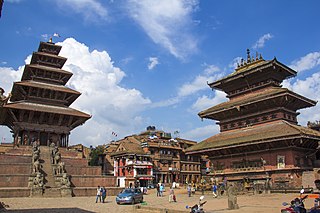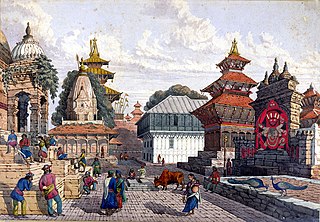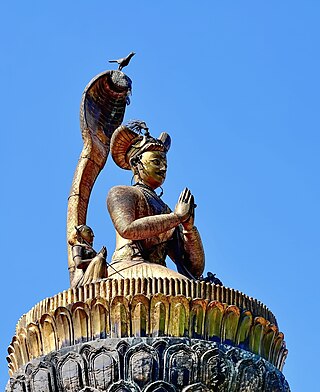
Kathmandu, officially Kathmandu Metropolitan City, is the capital and most populous city of Nepal with 845,767 inhabitants living in 105,649 households as of the 2021 Nepal census and approximately 4 million people in its urban agglomeration. It is located in the Kathmandu Valley, a large valley in the high plateaus in central Nepal, at an altitude of 1,400 metres.

Bhaktapur, known locally as Khwopa and historically called Bhadgaon, is a city in the east corner of the Kathmandu Valley in Nepal located about 13 kilometres (8.1 mi) from the capital city, Kathmandu. Bhaktapur is the smallest city of Nepal as well the most densely populated. Along with Kathmandu and Lalitpur, Bhaktapur is one of the three main cities of the Kathmandu Valley and is a major Newar settlement of the country. The city is also known for its Newar tradition, cuisine and artisans. Bhaktapur suffered heavy damage in the April 2015 earthquake.

The unification of Nepal was the process of building the modern Nepalese state, from fractured petty kingdoms including the Baise Rajya and the Chaubisi Rajya, which began in 1743 AD. The prominent figure in the unification campaign was Prithvi Narayan Shah, King of Gorkha. On 25 September 1768, he officially announced the creation of the Kingdom of Nepal and moved his capital from Gorkha to the city of Kathmandu.

The Malla dynasty was the ruling dynasty of the Kathmandu Valley in Nepal from 1201 to 1779. This dynasty was founded by Arideva Malla. Though latter Mallas were regarded as belonging to the Raghuvamsha dynasty, they were also seen as continuation and descendants of the Licchavi dynasty. Later Malla kings also traced one section of their lineage from Nanyadeva, the founder of the Karnat dynasty of Mithila. The term malla means wrestler in Sanskrit. The first use of the word malla in the Kathmandu Valley begins from 1201.

Jaya Prakash Malla was the last king of Kantipur which corresponds to present-day Kathmandu. He ruled from 1736 to 1746 after succeeding his father Jagajjaya Malla, and then from 1750 until his death in 1769.
Raya Malla was a Malla Dynasty king and the first King of Bhadgaon after the division of Kathmandu Valley into Kantipur, Patan, and Bhadgaon. He reigned from 1482 until his death in 1505. He was the son of Jayayakshya Malla. His younger brother, Ratna Malla, ruled over Kantipur.

Jayayakshya Malla was the son of Jayajyotir Malla and the last Malla king of the united Kathmandu Valley from around 1428 until his death in 1482. The valley was divided among his sons after his death.

Siva Simha Malla, also known as Shiva Simha or Shivasimha, was a Malla ruler and the sixth king of Kantipur. He started his reign on 1578 after deposing his brother Sadashiva Malla.

Pratap Malla was a Malla king and the eighth King of Kantipur from 1641 until his death in 1674. He attempted to unify Kathmandu Valley by conquering Lalitpur and Bhaktapur, but failed in the effort. He was successful in extending and securing the borders of Kantipur and was responsible for the monopoly over trade with Tibet. The resulting prosperity was responsible for the construction of majority of the buildings around Durbar Square during his reign. His reign is seen as a cultural and economical high point of the Malla dynasty.

The Battle of Kathmandu or siege of Kathmandu or siege of Kantipur occurred during the Unification of Nepal. It was fought in Kathmandu in 1768, and resulted in the defeat of its king Jaya Prakash Malla by conquerors Prithvi Narayan Shah, king of the adjoining Gorkha Kingdom.

The Battle of Lalitpur in 1768 ended with the Gorkha conquest of Lalitpur, one of the three kingdoms in Nepal centered in the Kathmandu Valley, and the loss of the rule of the native Newars.
Ratna Malla was a Malla king and the first independent king of Kantipur. He was one of the six sons of Yakshya Malla.
Surya Malla was a king of the Malla dynasty and the second king of Kantipur. He succeeded his father Ratna Malla and ruled from 1520 to 1530.
The Kingdom of Lalitpur, also known as Patan, was a kingdom ruled by the Malla dynasty of Nepal. It was established in 1482 after King Yaksha Malla's death. His sons divided the kingdom into four parts: Bhaktapur, Kantipur, Lalitpur, and Banepa.

The Kingdom of Bhaktapur, also known as Bhadgaon, was a kingdom ruled by the Malla dynasty of Nepal from 15th century until its annexation in the 18th century. It was established in 1482 after King Yaksha Malla died and his sons divided the valley into four kingdoms: Bhaktapur, Kantipur, Patan, and Banepa. Banepa, however, was soon annexed by or submitted itself to Bhaktapur.
Sadashiva Malla was a king of the Malla dynasty and the fifth king of Kantipur. He succeeded his father Mahendra Malla and ruled from 1574 to 1578.
Nripendra Malla was a Malla ruler and the ninth king of Kantipur. He succeeded his father Pratap Malla in 1674 as the King of Kantipur.
Siddhi Narasimha Malla, also known as Siddhinarasimha or Siddhi Narasingh, was a Malla dynasty king and the King of Patan. He was a religious king and ruled as the King of Patan from 1619 to 1661.

Yoga Narendra Malla, also known as Yoganarendra, was a Malla dynasty king and the King of Patan. He was the son of Srinivasa Malla and reigned on Patan from 1685 until his death in 1705.











